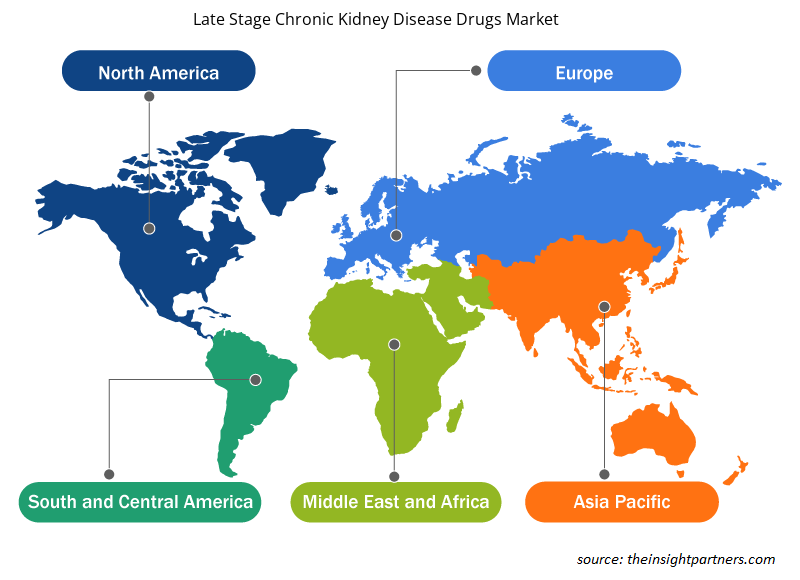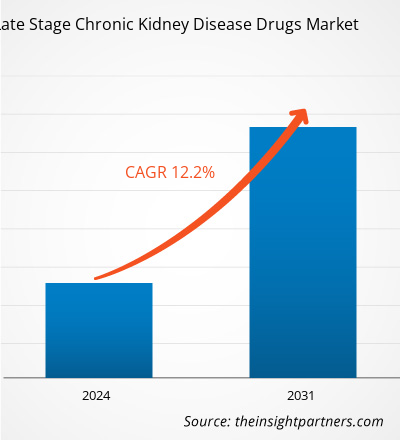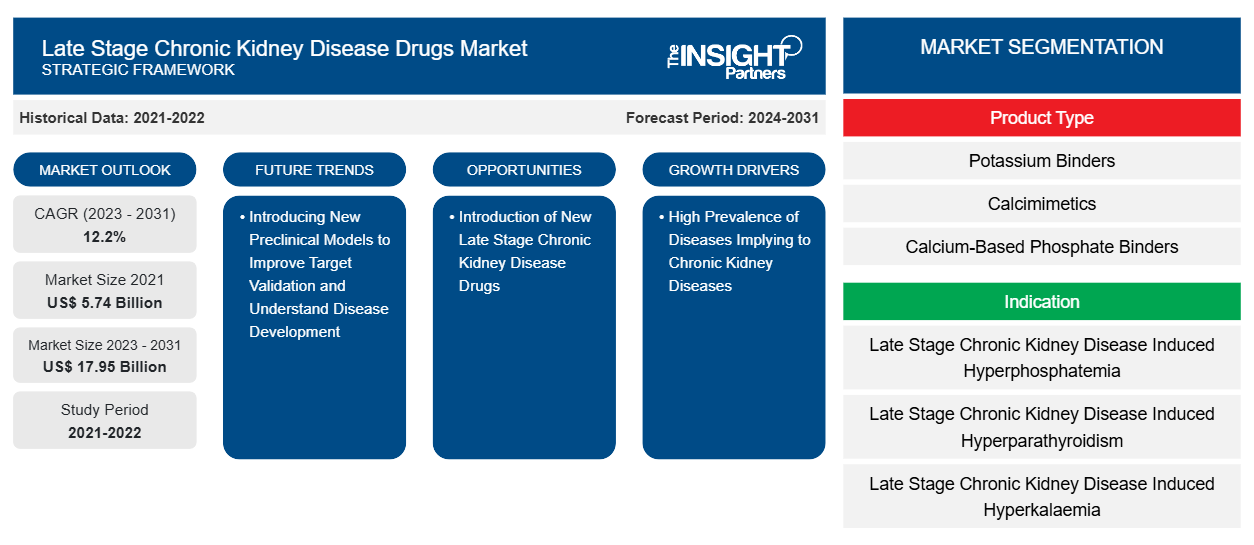晚期慢性肾病药物市场规模预计在 2021 年为 57.4 亿美元,在 2023 年为 XX 亿美元,预计到 2031 年将达到 179.5 亿美元;预计 2023-2031 年的复合年增长率为 12.2%。导致慢性肾病的疾病患病率高和有利的报销政策是驱动因素。引入新的临床前模型来改善靶标验证和了解疾病发展可能仍将是晚期慢性肾病药物市场趋势的关键。
晚期慢性肾病药物市场分析
世卫组织已规划了各种策略来支持政策制定者制定适当的政策,包括重要药物清单的概念和全民健康覆盖 (UHC) 方法。此外,拥有先进 UHC 和社会保障体系的欧洲国家已经制定了药品定价和报销制度,旨在免费或以低价向其公民提供各种重要药物。此外,根据 2024 年 CY 的 ESRD PPS,医疗保险预计将向大约 7,900 家 ESRD 机构支付 67 亿美元以提供肾透析服务。最终的 2024 年 CY ESRD PPS 基准费率为 271.02 美元,比目前的 2023 年 CY 基准费率 265.57 美元增加 5.45 美元。
晚期慢性肾病药物市场概况
亚太地区是晚期慢性肾病药物增长最快的市场。这一增长主要得益于 ESRD 患者数量的增加以及糖尿病和高血压(肾衰竭的主要原因)患病率的上升。在亚太国家,早期 CKD 患者进展为终末期肾病 (ESRD),对肾脏替代疗法的依赖程度不同。由于老龄化和 CKD 风险因素(包括糖尿病和高血压)负担的增加,CKD 已成为全球主要死亡原因之一。
定制此报告以满足您的需求
您可以免费定制任何报告,包括本报告的部分内容、国家级分析、Excel 数据包,以及为初创企业和大学提供优惠和折扣
-
获取此报告的关键市场趋势。这个免费样品将包括数据分析,从市场趋势到估计和预测。
晚期慢性肾病药物市场驱动因素和机遇
导致慢性肾脏病的疾病患病率高
美国国家医学图书馆指出,慢性肾病(CKD)是全球公认的首要公共卫生问题。全球CKD的患病率估计为13.4%,需要肾脏替代治疗的终末期肾病(ESKD)患者估计在490.2万至708.3万之间。此外,美国疾病控制与预防中心(CDC)公布,在美国,估计每7名美国成年人中就有1人以上,即3550万人,即14%患有CKD。此外,每10名患有CKD的成年人中就有9人不知道自己患有CKD。
晚期慢性肾病新药的引入——一个机遇
制造商正专注于采用产品发布和批准、研发投资、政府资助和合作等策略来开发新药并为全球患者提供便捷的获取途径。例如,2021 年 4 月,美国食品药品监督管理局批准了 Farxiga(达格列净)口服片剂,以降低有疾病进展风险的慢性肾病患者肾功能衰退、心血管死亡、肾衰竭和其他相关问题的风险。
北美、欧洲和亚洲各国对这种药物的采用率显著增加。
晚期慢性肾病药物市场报告细分分析
有助于得出晚期慢性肾病药物市场分析的关键部分是产品类型、适应症和分销渠道。
- 根据产品类型,晚期慢性肾病药物市场细分为维生素 D、钙基磷酸盐结合剂、钾结合剂、钙拟药等。钙拟药细分市场在 2023 年占据最大市场份额,预计同一细分市场在预测期内的复合年增长率最高。
- 根据适应症,晚期慢性肾病药物市场细分为晚期慢性肾病引起的甲状旁腺功能亢进症、晚期慢性肾病引起的高磷血症和晚期慢性肾病引起的高钾血症。晚期慢性肾病引起的甲状旁腺功能亢进症细分市场在 2023 年占据最大市场份额,而同一细分市场预计在预测期内将实现最高复合年增长率。
- 根据分销渠道,晚期慢性肾病药物市场分为医院药房、在线药房和零售药房。医院药房部分在 2023 年占据最大的市场份额。然而,预计在预测期内,在线药房的复合年增长率最高,为 12.2%。
晚期慢性肾病药物市场份额按地区分析
晚期慢性肾病药物市场报告的地理范围主要分为五个地区:北美、亚太、欧洲、中东和非洲、南美/南美和中美。
北美晚期慢性肾病药物市场分为美国、加拿大和墨西哥。2023 年,美国占据北美晚期慢性肾病药物市场的最大份额。北美晚期慢性肾病药物市场预计增长的原因是主要市场参与者的存在、终末期肾病和慢性肾病的不断增长以及各种学术和研究机构指导的大量研发。CKD 是国内外的主要公共卫生负担。CKD 的全球平均患病率为 13.4%,在加拿大,最新估计表明至少有 400 万人患有这种疾病。CKD 给医疗保健系统带来了沉重的负担:最近估计,加拿大 CKD 患者的医疗保健费用每年超过 400 亿美元。这种疾病在患有高血压、心血管疾病、糖尿病和其他健康不良的人群中更为常见。
晚期慢性肾病药物市场区域洞察
Insight Partners 的分析师已详尽解释了预测期内影响晚期慢性肾病药物市场的区域趋势和因素。本节还讨论了北美、欧洲、亚太地区、中东和非洲以及南美和中美洲的晚期慢性肾病药物市场细分和地理位置。

- 获取晚期慢性肾病药物市场的区域特定数据
晚期慢性肾病药物市场报告范围
| 报告属性 | 细节 |
|---|---|
| 2021 年市场规模 | 57.4 亿美元 |
| 2031 年市场规模 | 179.5亿美元 |
| 全球复合年增长率(2023 - 2031) | 12.2% |
| 史料 | 2021-2022 |
| 预测期 | 2024-2031 |
| 涵盖的领域 |
按产品类型
|
| 覆盖地区和国家 |
北美
|
| 市场领导者和主要公司简介 |
|
晚期慢性肾病药物市场参与者密度:了解其对业务动态的影响
晚期慢性肾病药物市场正在快速增长,这得益于终端用户需求的不断增长,而这些需求又源于消费者偏好的不断变化、技术进步以及对产品优势的认识不断提高等因素。随着需求的增加,企业正在扩大其产品范围,进行创新以满足消费者的需求,并利用新兴趋势,从而进一步推动市场增长。
市场参与者密度是指在特定市场或行业内运营的企业或公司的分布情况。它表明在给定市场空间中,相对于其规模或总市场价值,有多少竞争对手(市场参与者)存在。
在晚期慢性肾病药物市场运营的主要公司有:
- 艾伯维公司(AbbVie Inc.)
- 安进
- 阿斯利康
- 赛诺菲
- 协和麒麟株式会社
- 武田药品工业株式会社
免责声明:上面列出的公司没有按照任何特定顺序排列。

- 了解晚期慢性肾病药物市场顶级关键参与者概况
晚期慢性肾病药物市场新闻和最新发展
晚期慢性肾病药物市场通过收集来自一级和二级研究的定性和定量数据进行评估,其中包括重要的公司出版物、协会数据和数据库。以下是晚期慢性肾病药物市场的发展列表:
- Sun Pharma 和拜耳联合同意销售一种治疗慢性肾病的药物。根据协议条款,拜耳授予 Sun Pharma 非独家权利,以 Lyvelsa 品牌销售和分销第二种 Finerenone 产品。(拜耳/新闻稿,2024 年 1 月)
- 勃林格殷格翰与礼来公司宣布,FDA 批准 Jardiance(恩格列净)片剂,该片剂有望降低患有慢性肾病 (CKD) 的成年人患肾病和心血管死亡的风险。(来源:勃林格殷格翰国际有限公司,新闻稿,2023 年 10 月)
晚期慢性肾病药物市场报告覆盖范围和交付成果
“晚期慢性肾病药物市场规模和预测(2021-2031)”报告对市场进行了详细分析,涵盖以下领域:
- 范围内所有主要细分市场的全球、区域和国家层面的市场规模和预测
- 市场动态,如驱动因素、限制因素和关键机遇
- 未来主要趋势
- 详细的 PEST/波特五力分析和 SWOT 分析
- 全球和区域市场分析涵盖关键市场趋势、主要参与者、法规和最新市场发展
- 行业格局和竞争分析,涵盖市场集中度、热点图分析、知名参与者和最新发展
- 详细的公司简介
- 历史分析(2 年)、基准年、预测(7 年)及复合年增长率
- PEST和SWOT分析
- 市场规模、价值/数量 - 全球、区域、国家
- 行业和竞争格局
- Excel 数据集
近期报告
相关报告
客户评价
购买理由
- 明智的决策
- 了解市场动态
- 竞争分析
- 客户洞察
- 市场预测
- 风险规避
- 战略规划
- 投资论证
- 识别新兴市场
- 优化营销策略
- 提升运营效率
- 顺应监管趋势























 获取免费样品 - 晚期慢性肾病药物市场
获取免费样品 - 晚期慢性肾病药物市场